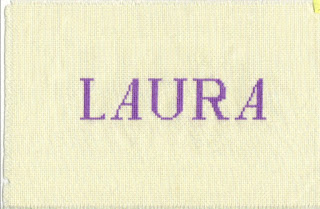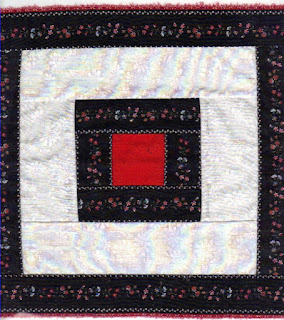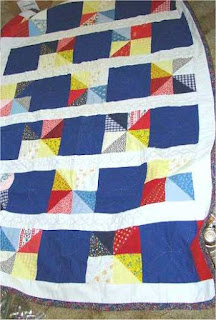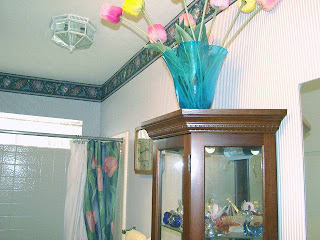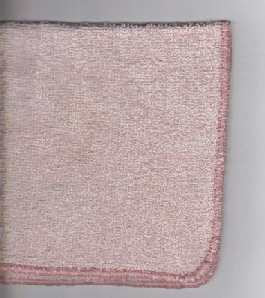Christmas Crafts You Can Make -- Instructions for Ribbon Weaving and Fabric
 |
| Weave the ribbons from center to edges |
Thanksgiving is over and it's time to get your Christmas crafts for display or gifts. If you have rolls of inexpensive ribbon you've accumulated from sales, thrift purchases or auctions, you may be surprised that this is the year you can use them for crafts projects. They don't just wrap the gift, they are the gift.
You can make a pillow or tree ornaments or even a purse. Here's how to make the ribbon fabric to make gifts of your choice.
You'll need:
Foamcore or smooth cardboard a little larger than the item you want to make.
Heat n Bond or similar bonding
material large enough to fit the foam core or cardboard
Ribbon in different colors that will
withstand a little heat
Straight pins, iron, ruler and
scissors
Matching fabric for pillow back,
purse or ornament
Make a Board to Work On
Cut the foamcore (like poster paper with foam center) or cardboard to a square size you can use for your project. If you want to make a large item such as a pillow, a 20 by 20 inch square will do, but if you want to make a Christmas ornament, a 10 by 10 inch square is a good size to start.
Cover the Board
Cover the board with Heat n Bond, Stitch Witchery or Wunder Under -- any kind of bonding fabric that will attach to the ribbon with heat. A large board will require more than one piece of bonding material. Attach the bonding with clear tape at the back of the board. Make it secure, but don't let it wrinkle. Match two pieces with no overlap, just butting the bonding together. Don't tape on the front -- just on the back.
Mark Measurements on Sides
Use a ruler to mark all sides of the covered board at 1-inch intervals. These are your guidelines for your design.
Select Your Design and Get Started
Choose how you want to make the design -- you can do a diagonal or a square. Either one will work with the 1-inch marks.
Cut ribbon in lengths at least 2 inches longer than your board.
Start in the middle and place a few ribbons horizontally or diagonally across the board, using the measurements as a guide and securing it with a straight pin on each side. I pushed the pins from the side to the back so they wouldn't be in the way on the front, but work with your board to see what works for you.
Weave the Ribbon
Weave a few ribbons vertically or diagonally through the horizontal or diagonal ones, not overlapping and not leaving any gaps. If you're working with a white bonding fabric and white ribbon, watch for spaces at the corners of the crossing ribbon.
Continue weaving over and under until you get a piece of ribbon fabric the size you need to make your item. As small as 12 inches by 12 inches will make a pillow, but you can use smaller pieces of ribbon fabric for Christmas ornaments or the front of a purse for a Christmas gift.
Make a Board to Work On
Cut the foamcore (like poster paper with foam center) or cardboard to a square size you can use for your project. If you want to make a large item such as a pillow, a 20 by 20 inch square will do, but if you want to make a Christmas ornament, a 10 by 10 inch square is a good size to start.
Cover the Board
Cover the board with Heat n Bond, Stitch Witchery or Wunder Under -- any kind of bonding fabric that will attach to the ribbon with heat. A large board will require more than one piece of bonding material. Attach the bonding with clear tape at the back of the board. Make it secure, but don't let it wrinkle. Match two pieces with no overlap, just butting the bonding together. Don't tape on the front -- just on the back.
Mark Measurements on Sides
Use a ruler to mark all sides of the covered board at 1-inch intervals. These are your guidelines for your design.
Select Your Design and Get Started
Choose how you want to make the design -- you can do a diagonal or a square. Either one will work with the 1-inch marks.
Cut ribbon in lengths at least 2 inches longer than your board.
Start in the middle and place a few ribbons horizontally or diagonally across the board, using the measurements as a guide and securing it with a straight pin on each side. I pushed the pins from the side to the back so they wouldn't be in the way on the front, but work with your board to see what works for you.
Weave the Ribbon
Weave a few ribbons vertically or diagonally through the horizontal or diagonal ones, not overlapping and not leaving any gaps. If you're working with a white bonding fabric and white ribbon, watch for spaces at the corners of the crossing ribbon.
Continue weaving over and under until you get a piece of ribbon fabric the size you need to make your item. As small as 12 inches by 12 inches will make a pillow, but you can use smaller pieces of ribbon fabric for Christmas ornaments or the front of a purse for a Christmas gift.
 |
| Use different sizes of ribbons for interest |
Iron the Bonding to the Ribbon
Once you have the ribbon woven on the bonding fabric and secured, you're ready to make the fabric. Follow the instructions on the bonding material -- it probably recommends a dry iron and medium temperature for 5 to 7 seconds of pressing. Allow the fabric to cool.
Remove the bonding fabric from the board by removing the pins and releasing the tape on the back.
Cut Your Shapes
Cut the shape you need for your project. I made a diagonal design that would make diamond shapes for tree ornaments, a pillow or purse front.
 |
| Ribbon fabric ready to make a Christmas ornament |
Peel the Paper Off
Peel the paper backing off the bonding fiber so you have a flexible ribbon fabric. Stitch around the shape to keep all the ribbons in place.
Use the Fabric
Use the ribbon fabric just as you would any other fabric, but reinforce it with a backing or lining for years of use. To make a diamond ornament like this, cut a backing fabric the size of your diamond. Place right sides together and stitch around the ornament, leaving an opening at the top to turn it and to add a hanger. Turn it right side out and close the opening with hand stitches or with the sewing machine, adding a ribbon loop for hanging.
This doesn't take much time (or thought) and the ribbon fabric is easy to work with once it's made.
Have a great holiday season!
Linda
cajunC




